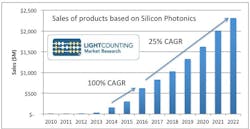Silicon photonics' effect more evolutionary than revolutionary: LightCounting
LightCounting agrees with the proponents of silicon photonics that the photonic integration strategy has the potential to benefit a wide variety of applications. However, the market research firm opines in its recently released "Integrated Optical Devices: Is Silicon Photonics a Disruptive Technology?" report that it will take several years before silicon photonics remakes the optical communications design landscape.
For example, LightCounting believes that optical transceivers based on silicon photonics technology will represent less than 2.5% of total units shipped in 2022. Most of these optical modules will target applications at 100 Gbps and greater – and will be priced accordingly, the market research company predicts.
Therefore, those expecting silicon photonics to radically reduce optical transceiver prices will be disappointed, LightCounting expects. The company explains that if the technology's main calling card is efficient integration of discrete functions, it's best used for large-scale integration applications. Typical optical requirements for the integration of, say, two or four functions can be served via other approaches, such as InP or GaAs, at least for the next decade or two.
If silicon photonics is to prove truly disruptive, it must enable capabilities InP and GaAs can't, LightCounting asserts. Integration of optical functions with ASICs could be one example, according to the report.
All of this is not to say that there isn't a market for silicon photonics enabled devices in the near term. LightCounting points out that sales of optical transceivers designed with silicon photonics exceeded $600 million last year, twice the market as the previous year. And sales of similar technology in 2022 should surpass $2 billion by 2022 (see chart above).
For related articles, visit the Business Topic Center.
For more information on optical modules and suppliers, visit the Lightwave Buyer's Guide.
